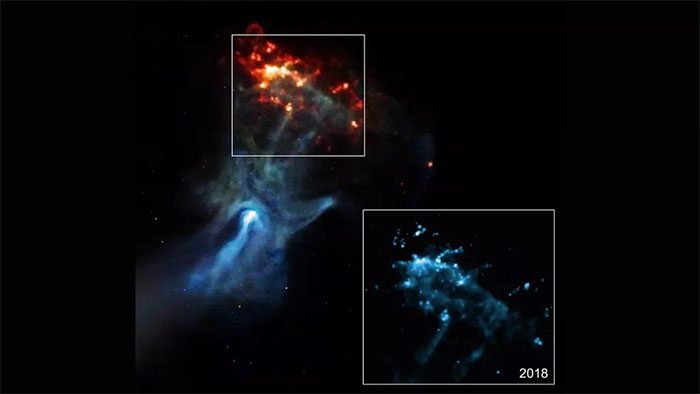A “giant ghostly hand” reaching out into the deep space is what scientists have observed following a supernova explosion.
“Giant ghostly hand” may sound like science fiction, but this image was captured by the Chandra X-ray Observatory of NASA.

Image of the ghostly hand reaching out in deep space.
Members of the Chandra team noted that this “ghostly hand” was formed by the death of a massive star in a supernova explosion. The explosion left behind a rapidly spinning, super-dense stellar remnant known as a pulsar.
This pulsar has created a bubble of energetic particles around itself, combined with debris from the supernova explosion, forming a structure that resembles a hand extending 150 light-years.
Meanwhile, the glowing cloud that the fingers of the “ghostly hand” reach out to is a massive gas cloud known as RCW 89.
The supernova remnant located in the center of the hand, called MSH 15-52, is approximately 17,000 light-years away from Earth. Astronomers believe that the light from the supernova explosion reached Earth about 1,700 years ago, making MSH 15-52 one of the youngest known supernova remnants in our Milky Way galaxy. At that time, China was in the midst of the “Rebellion of the Eight Kings” of the Jin Dynasty – the year 300 AD, the first year of Yongkang of the Western Jin Dynasty. The “Book of Jin” records that “a ghostly star appeared in the south.” If this so-called “ghost star” was not a comet, it is quite possible that it was the neutron star designated MSH15-52 that flared up at the time of the supernova explosion.
This neutron star is 17,000 light-years away from Earth, and its light has been traveling to us for 1,700 years, meaning that about 18,700 years have passed since the explosion of this neutron star. However, for stars in the universe, this duration is relatively short, so it is still considered a young supernova in the Milky Way.
The Chandra Observatory has found that this neutron star is still spinning rapidly and continuously emitting beams of electromagnetic radiation outward. Therefore, it is also classified as a pulsar. The nebula where it is located was first detected by Chandra in April 2009. However, the latest images show that the shock wave from the supernova at its “fingertip” is moving at a speed of about 14.5 million km/h, while the material near the palm is moving even faster, exceeding 17.7 million km/h, nearly 5,000 km per second, which can be described as this “ghostly palm” still extending outward at a speed of 5,000 km per second.
Chandra has been observing the universe in X-ray light for over two decades. The telescope was launched into Earth orbit aboard the shuttle Columbia in July 1999.
Chandra is one of four “Great Observatories” of NASA, launched between 1990 and 2003. The other telescopes include the Hubble Space Telescope, which is still operational today (though currently facing a computer issue); the Compton Gamma Ray Observatory, launched in 1991 and concluded its mission in 2000; and the Spitzer Space Telescope, optimized for infrared, launched in 2003 and ceased operations last year.




















































